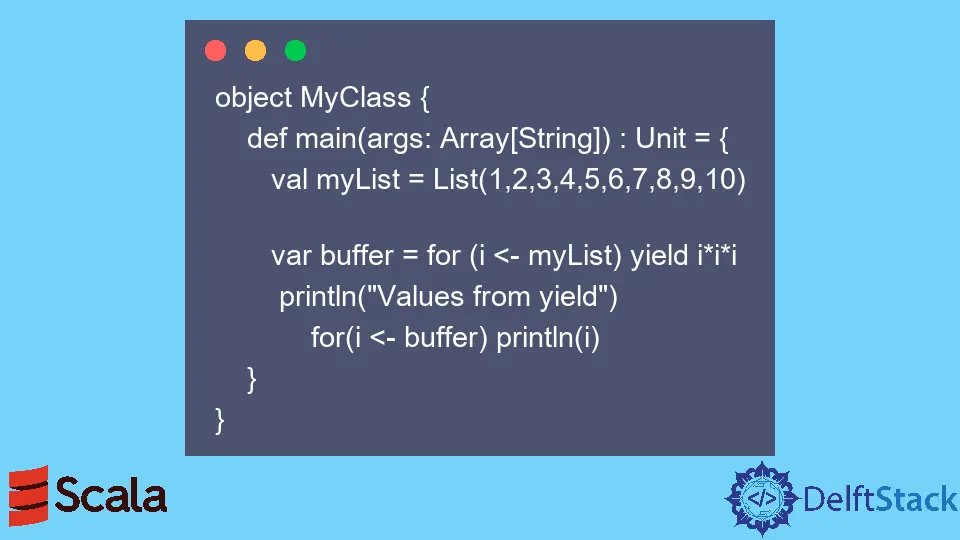The yield Keyword in Scala Programming Language
- Understanding the Yield Keyword
- Using Yield with Collections
- Yield in Nested For Comprehensions
- Practical Applications of Yield
- Conclusion
- FAQ

In the world of Scala programming, the yield keyword is a powerful tool that allows developers to create collections in a more expressive and readable manner. Whether you are working with lists, arrays, or other collections, understanding how to effectively utilize yield can significantly enhance your coding efficiency.
This article will delve into the intricacies of the yield keyword, illustrating its usage through practical examples. We will explore how yield can transform a simple iteration into a dynamic collection-building process, making your code cleaner and more maintainable. So, if you’re ready to elevate your Scala programming skills, let’s dive into the fascinating world of yield.
Understanding the Yield Keyword
The yield keyword in Scala is primarily used within a for comprehension. It allows you to iterate over a collection and produce a new collection based on the results of the iteration. This is particularly useful when you want to apply a transformation to each element in a collection without explicitly writing out the collection-building logic.
Here’s a simple example of using yield with a list of numbers:
val numbers = List(1, 2, 3, 4, 5)
val doubled = for (n <- numbers) yield n * 2
Output:
List(2, 4, 6, 8, 10)
In this code snippet, we start with a list of numbers. The for comprehension iterates through each number n, and for each iteration, it multiplies n by 2. The result is a new list containing the doubled values. This concise approach not only makes the code easier to read but also eliminates the need for additional methods to build the new collection.
Using Yield with Collections
One of the significant advantages of the yield keyword is its ability to work seamlessly with various collection types in Scala. Whether you are dealing with lists, sets, or arrays, yield can simplify your code significantly. Let’s take a look at how yield can be applied to a set.
val originalSet = Set(1, 2, 3, 4, 5)
val squaredSet = for (n <- originalSet) yield n * n
Output:
Set(1, 4, 9, 16, 25)
In this example, we have a set of numbers. The yield keyword allows us to create a new set where each number is squared. This transformation is done in a single line, demonstrating the power of yield in reducing boilerplate code.
The beauty of using yield lies in its flexibility. You can easily adapt it to different collection types, making it a versatile tool in your Scala programming toolkit. This method not only enhances readability but also optimizes performance by leveraging Scala’s functional programming capabilities.
Yield in Nested For Comprehensions
Another powerful aspect of yield is its ability to handle nested collections through nested for comprehensions. This is particularly useful when dealing with multi-dimensional data structures. Here’s how you can use yield in a nested context.
val matrix = Array(Array(1, 2), Array(3, 4))
val flattened = for {
row <- matrix
element <- row
} yield element * 2
Output:
Array(2, 4, 6, 8)
In this example, we have a two-dimensional array (or matrix). The outer for comprehension iterates over each row, while the inner comprehension iterates over each element within that row. By using yield, we can create a flattened array where each element is doubled.
This approach not only simplifies the logic but also makes it easier to understand how data flows through the nested structures. As you can see, yield can effectively handle complex data transformations, making it an invaluable tool in Scala programming.
Practical Applications of Yield
The yield keyword can be applied in various real-world scenarios, such as data processing, transformations, and even in functional programming paradigms. For instance, consider a situation where you need to filter and transform a list of names based on their lengths.
val names = List("Alice", "Bob", "Charlie", "David")
val longNames = for {
name <- names
if name.length > 3
} yield name.toUpperCase
Output:
List(ALICE, CHARLIE, DAVID)
In this example, we have a list of names. The for comprehension uses a guard (if statement) to filter names longer than three characters. The yield then transforms those names to uppercase. This showcases the power of yield in combining filtering and transformation in a clean and readable manner.
By leveraging yield, Scala programmers can write more expressive code that succinctly captures the intent behind data transformations. This not only improves code quality but also enhances maintainability, making it easier for others (and yourself) to understand the logic behind your implementations.
Conclusion
The yield keyword in Scala is a potent feature that allows for elegant and efficient collection transformations. By using yield, developers can create new collections from existing ones while maintaining readability and reducing boilerplate code. Whether you’re working with lists, sets, or nested structures, yield offers a clear and concise way to express complex data manipulations. As you continue your journey in Scala programming, mastering the yield keyword will undoubtedly enhance your coding capabilities and improve your overall programming experience.
FAQ
-
What is the yield keyword in Scala?
Theyieldkeyword is used in Scala to create new collections from existing ones within aforcomprehension. -
Can yield be used with different collection types?
Yes,yieldworks seamlessly with various collection types, including lists, sets, and arrays. -
How does yield improve code readability?
By allowing for concise and expressive transformations,yieldreduces boilerplate code and makes the intent of the code clearer. -
Can yield handle nested collections?
Yes,yieldcan be used in nestedforcomprehensions to process multi-dimensional data structures effectively. -
What are some practical applications of yield?
Yieldis commonly used in data processing, filtering, and transformations in functional programming paradigms.
